

Creating a website design contract can be the difference between smooth project management and unforeseen disputes. Clear, precise agreements not only detail the project scope but also set payment terms, and establish ownership rights. It’s crucial to define each party’s responsibilities within the contractual agreement to prevent misunderstandings. This article will delve into the essentials of crafting a web design contract, covering payment schedules, intellectual property rights, and dispute resolution methods.
You’ll learn how to outline project deliverables, establish a sensible revisions policy, and include confidentiality agreements. By the end, you’ll be equipped to create a solid, legally binding web design agreement that protects both you and your clients, ensuring transparency and professionalism.
This guide breaks down crucial contract elements, explains the significance of milestone payments, and clarifies essential clauses such as the termination clause and confidentiality agreement. Confidently structuring your next web design contract starts here.
A few tips and design contract template examples are provided below by our team behind Slider Revolution to help you create a great web design contract for your business.
A web design contract legally binds the design agreement between a designer and their client. Both the client and designer must sign the document for the contract to be valid.
Such contracts contain design agreements on factors that include –
Outlined below are some reasons why a contract is important.
The modern world is very litigious, and drafting a contract is the only secure way to protect your interests when you take on a design job. Disagreements happen from time to time in business, and can cause you problems such as delayed payments and stalemates.
In these situations, your contract will protect you and ensure transparency with respect to renewals, contract dates and other important clauses, paving way for better IT management. In fact, dispute settlement is the most important part of a legal agreement — the contract will give details of what happens in case of a disagreement.
A well-designed web design contract should have ways of dealing with contingencies such as:
Such questions and anything else that you or your client decide is necessary, should be put into writing.
Given that contracts are essential, the question remains: How should it be composed?
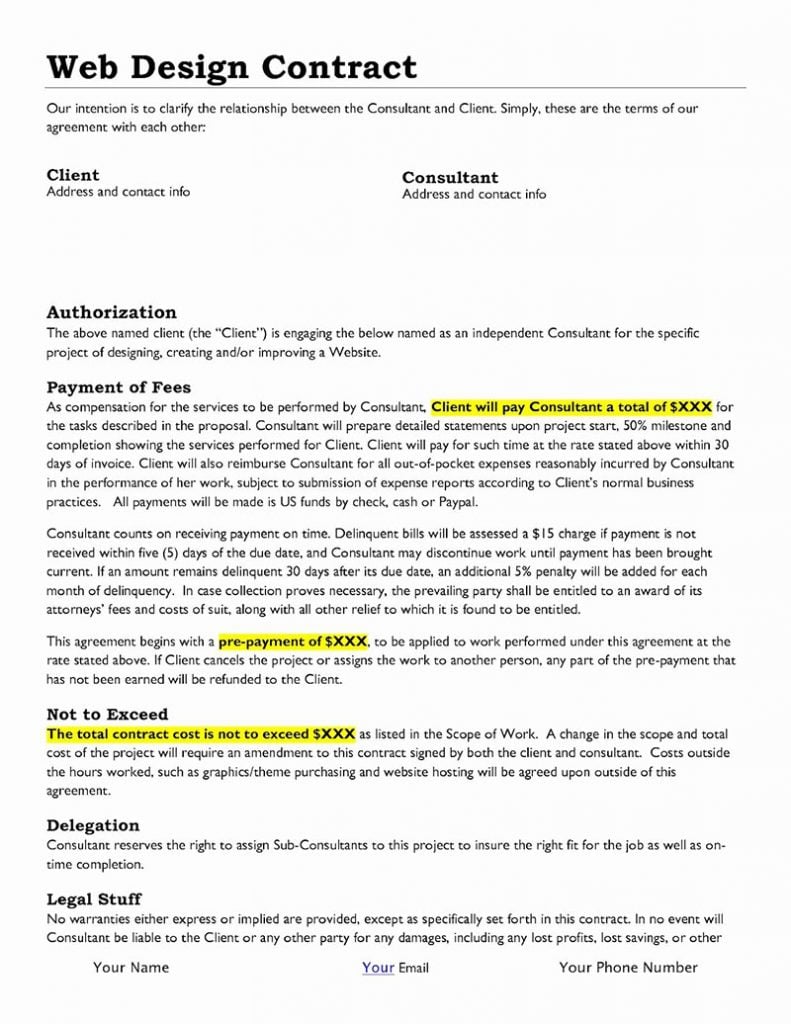
Lawyer-composed contracts can be quite difficult to read and understand.
So it is quite likely that an overly complicated web design contract will annoy your client and also lead to confusion.
The best strategy is to create a straightforward contract that makes sense to all parties. An average person should be able to understand the content and meaning. Use short and concise language to get your point across. Simple statements explained in no uncertain terms will eliminate the possibility of your client violating the contract by claiming a misunderstanding.
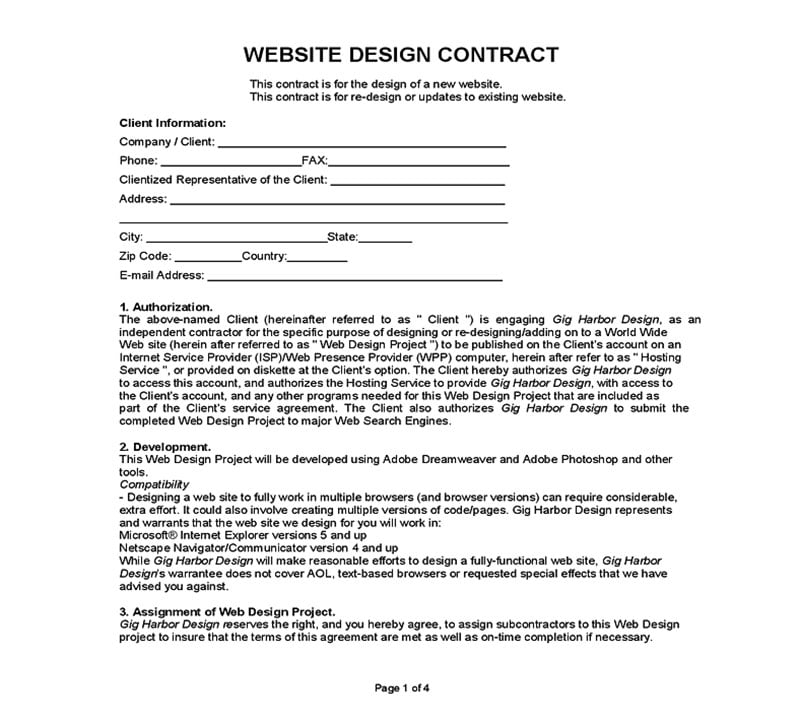
Have you ever had a client who expects far more work than you are being paid for?
To prevent this kind of exploitation, it’s important to set the scope of your work in writing. To work without such a scope can be dangerous. The client might ask you to start performing services or adding features that you did not sign up for. Eventually, this will lead to grand expectations and overwork, or a dissatisfied client.
Start by clearly communicating what you are going to do and set that in the contract, so there’ll be no nasty surprises. If necessary, you can politely refuse work that is out of the scope of the design agreement.
Alternatively, you can accept the work, but charge for it and be paid for your time.
Your legally defined scope of work should include –

Your client has a few responsibilities in any web design or web development project, and they should be included in your contract.
Great design only takes place when you collaborate and synergize with the client. You will first need a reliable point of contact, and you need to know who the ultimate decision-makers are.
In an ideal scenario, both roles are played by the same person. You can specify this in your contract to avoid problems with conflicting client opinions. Then, you should specify what information the client must provide to help your work, which might include their data and identity assets.
Clients are also part of the workflow, so make sure you write down what labor they are responsible for, for example, proofreading your work.

Unfortunately many web design professionals have experienced the situation where the work is complete, the mockup is sent, but the client is nowhere to be found.
Such situations are sometimes not the client’s fault. They usually have many pressing responsibilities and might ignore or forget aspects like web design or web development.
You can avoid this problem by including a clause specifying the number of days within which your client can review designs and get back to you.
WoW your clients by creating innovative and response-boosting websites
fast with no coding experience. Slider Revolution makes it possible for you
to have a rush of clients coming to you for trendy website designs.

The time frame of a project might also cause contention between web designers and their clients. Make sure that you and your client agree on the exact time frame of a project to avoid any timing surprises in the future.
You should go a step further and break down the entire project into milestones – with deadlines for each one.You also need feedback on your progress to ensure your work is meeting the client’s standards. Agree on feedback deadlines to avoid situations where you can’t make a deadline because the client is unavailable and has not provided feedback.

Intellectual property is very serious. Ensure that you have made a provision for who will take ownership of the project when your products are delivered. Usually, the client will do so after the completion of all payments.
You, as a web-designer, may want to retain ownership of the code of the site. You might also want to request clients to display a copyright notice at the bottom of their website design.
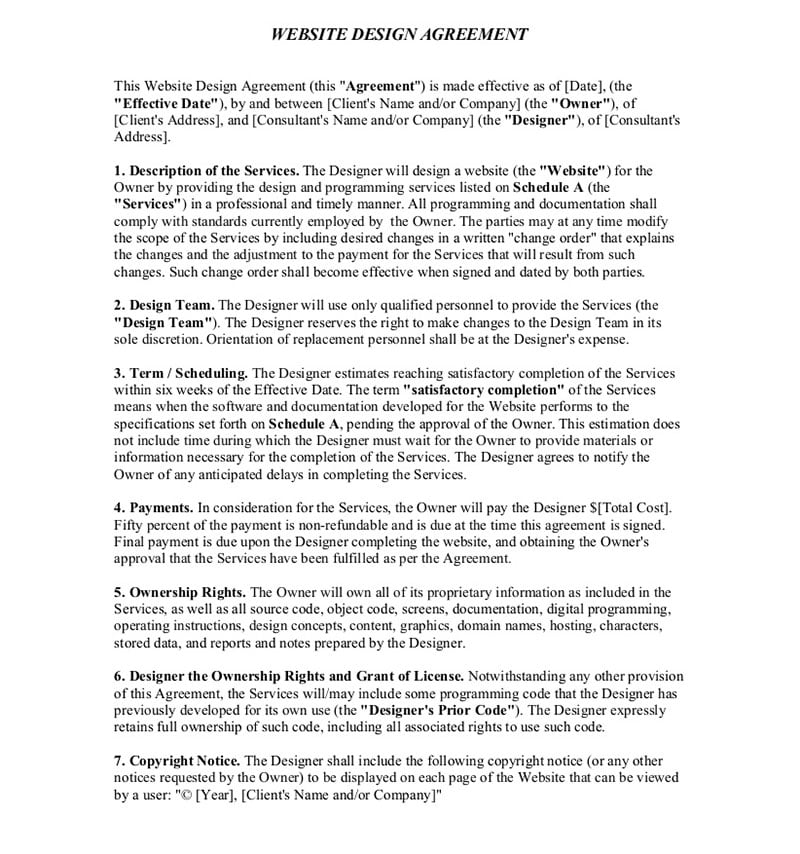
In order to be paid fairly you should first know how you will charge your client.
It is generally advisable to charge per-project for larger tasks, and charge by-the-hour for smaller ones where a time difference of 1 or 2 hours matters and must be reflected in your earnings.
Another possible charging method is a combination, whereby you can charge by the project and ask for an hourly rate for revisions.

Discerning clients often wish to include confidentiality clauses into their contracts, which will cover both you and your client.
Confidentiality clauses are useful if, for example, the client is working on a classified venture and and need you to keep it secret. Although it’s usually clients who request these, you can also cover yourself with a confidentiality clause if needed, and ask clients not to publicly discuss your business practices.
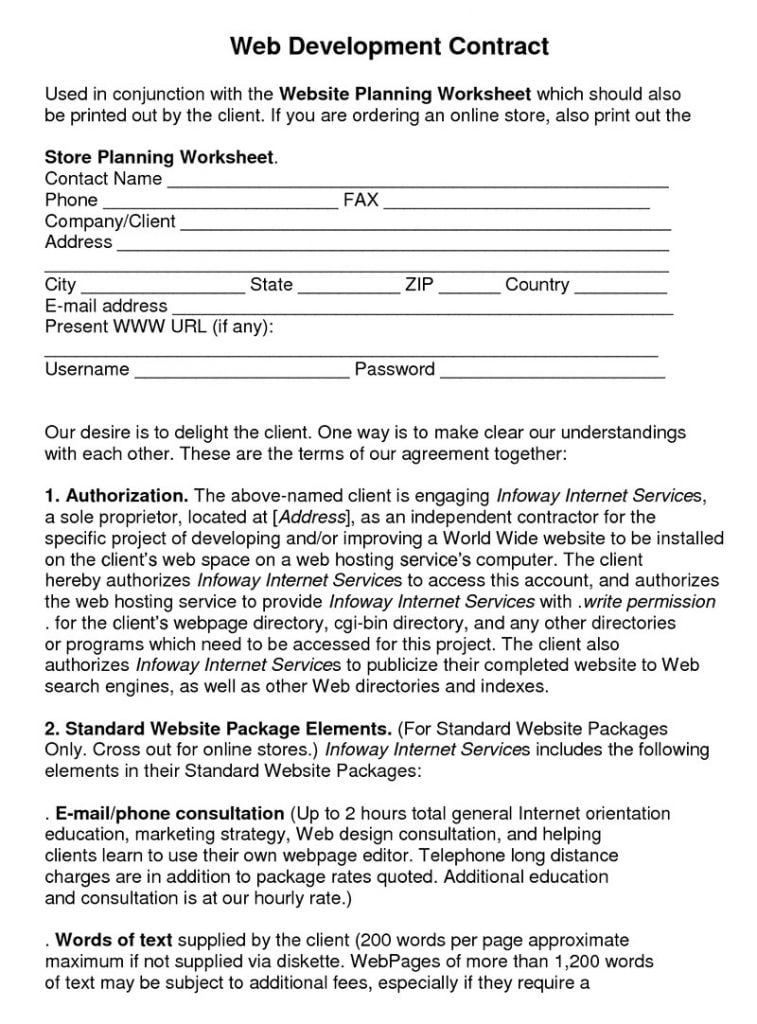
The situation can arise where you and client cannot work together due to personality clashes or some other reason, and you no longer want to honor the contract. Although contracts are normally legally binding, cancellation clauses can be a lifesaver as they define proceedings in case of a mutual or unavoidable pull-out of both parties.
A cancellation clause will also cover the scenario where you’ve already done a lot of work, but your client wants to withdraw. To ensure that you get paid, a cancellation clause requires that if the client wants to back out, they are legally bound to several requirements, including, but not limited to, payment for your time.
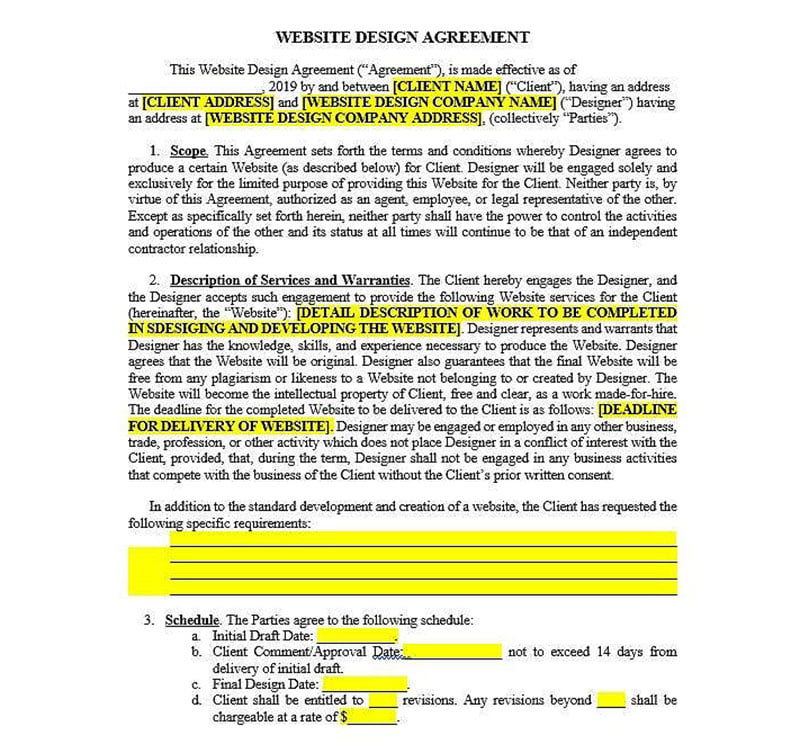
If both parties don’t sign a contract, it is not worth the paper it is printed on. Make sure that your contract has a final section where there is space for names and signatures.
If you can not meet your clients in person for signing the contracts, you can ensure that your contract is signed by a representative who has the authority to do so. Signing a contract involving a company is a little different than when dealing with an individual.
Make sure that you add the company name and the name and title of the authorized individual who signs the design agreement. A bonus tip is to have your client sign the contract first. If you sign last, you get the final choice of deciding whether to commit and make the contract binding.
As a best practice, you should send two copies for your client to sign. After they return them to you, sign both copies. Keep a copy for yourself and send one to the client.
Writing up your own contracts from scratch is challenging and time-consuming.
There is also always a possibility you may forget something vital and create problems in the future. The alternatives are, to pay someone to create your custom contract. However, that is usually expensive, and not justified to pay such an expense for every new project.
Alternatively use pre-written well-tested web design contract templates that already contain all the necessary elements. Websites like GitHub and Docracy host such free templates online.
The following are some of the best free contract templates for web designers:

Contract Killer is an Open Source web design contract template that is quite popular among web-professionals because it’s easy to understand and uses minimal legalese. It also has a touch of humor.
The web design contract template covers every major aspect, including:
A benefit of Contract Killer is that it is regularly updated.For instance, the latest revision includes technical issues such as SEO and mobile browser testing.

AIGA allows you to create customized terms and conditions for different types of design projects. The web design contract template can serve as a starting point that can be easily customized for each project. You can download it as a PDF, or even make desired adjustments online.
Another way to use the template is to borrow its terms and conditions and add them to a separate proposal document. AIGA includes detailed information on how to use the contract, including:
It also includes miscellaneous items like fees, responsibilities, expenses, definitions, timing, payment terms, exclusivity, confidentiality, infringement, and warranty.

Web Design Law’s Template is an excellent, comprehensive resource for all your contractual needs. It starts with a superb overview of contract development and use, then offers several different templates.
The web design contract template sets include letters of agreement, project proposals, a full and condensed version of terms and conditions, invoices, past due reminders, and template collections letters.


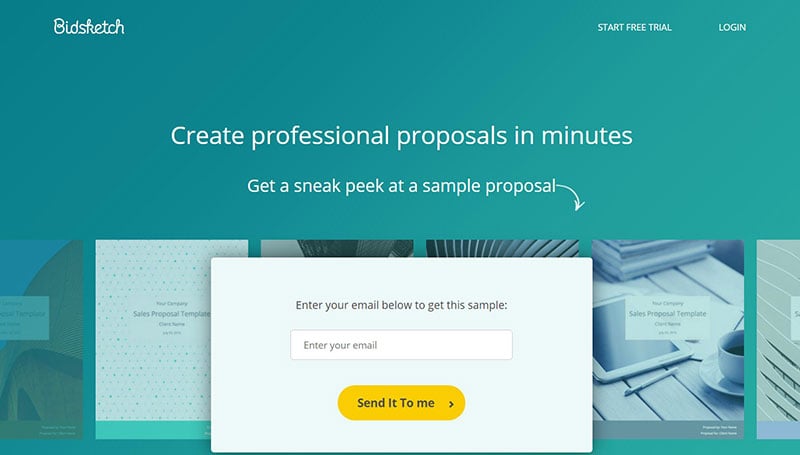
The BidSketch template package simplifies contracts by separating business and legal terms into two different sections.
Both sections combined cover almost everything a web designer may need and includes:
A website design contract should include key components like project scope, payment terms, project deliverables, revisions policy, confidentiality agreement, intellectual property rights, a termination clause, and dispute resolution methods. Clearly define each party’s responsibilities to prevent misunderstandings and safeguard all involved.
Outline the project scope by specifying the tasks, timelines, and deliverables. Include detailed descriptions to set clear expectations. This helps in avoiding scope creep and ensures everyone knows what is expected. Precise scopes make the entire web design process seamless and professional.
Payment terms set the financial groundwork for the project. They establish how and when payments will be made, including milestone payments. Clear payment schedules prevent conflicts and ensure timely compensation, enhancing trust and professionalism between parties.
A revisions policy outlines the number of revisions and what constitutes a revision. This section is pivotal in managing expectations and timelines. Specify what counts as minor or major revisions to avoid endless cycles of changes and ensure the project stays on track.
Specify intellectual property rights to clarify who owns the final design and any associated materials. Include details on copyright and usage rights. This section will prevent any post-project disputes about ownership and usage of the web design materials.
The contract should clearly spell out the client’s responsibilities, such as providing necessary content, assets, and timely feedback. This will ensure that the project timeline is adhered to and help avoid delays caused by waiting on client deliverables.
A termination clause provides an exit strategy if the project doesn’t go as planned. Detail circumstances under which either party can terminate the contract and the resulting implications. This part ensures a fair and legally sound conclusion to a partnership if needed.
A confidentiality agreement keeps sensitive project details secure. It ensures that proprietary information, designs, and business insights are not shared with unauthorized parties. This agreement builds trust and protects essential business information throughout and after the project.
Dispute resolution methods outline how conflicts will be handled. Whether through mediation, arbitration, or legal action, specifying this in advance helps manage disputes effectively. It provides a clear path to resolution and minimizes disruptions to the project.
Using a web design contract template can be beneficial but customize it to fit your specific needs. Make sure it covers all necessary sections like licensing terms, SEO services, and maintenance contracts. A tailored approach ensures all nuances of your web design services are appropriately addressed.
Creating a website design contract is fundamental for safeguarding project integrity and managing client relationships effectively. It ensures clear payment terms, defines the project scope, and establishes intellectual property rights. Properly crafted contracts reduce misunderstandings, clarify client responsibilities, and make room for a revisions policy that keeps projects on track.
From specifying milestone payments to including a strong confidentiality agreement and a well-thought-out termination clause, each component is vital. They collectively protect both parties, ensuring a professional and smooth design process.
By addressing critical elements such as dispute resolution methods and using carefully tailored web design contract templates, you can create comprehensive agreements. These documents will fortify your business relationships and legal standing.
If you liked this web design contract guide, you should check out this one with tips for creating a website design questionnaire.
We also wrote about other useful topics, like the coolest fonts, CSS frameworks, and dummy text generator tools.
The Web Design Contract Guide: Tips and Templates to useGet a complete grip on all aspects of web designing to build high-converting and creativity-oozing websites. Access our list of high-quality articles and elevate your skills.
Slider Revolution high priest on the mission to find the line between not enough coffee and just a little too much coffee. Same with beer.
For any inquiries or additional resources related to this blog post or else, please don't hesitate to comment below or email me at [email protected] .